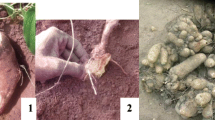Conclusions
In general, almost all programs have experienced difficulties of virus infections and/or other diseases in the cutting operations. A careful and systematic testing program must be developed with micro-propagation methods. More production ofin vitro plantlets and cuttings is usually needed in the early years of a program than is needed later. The re-use of non-certified seed derived from high quality certified seed eventually reduces the demand for certified seed. Over production of cuttings is not an uncommon occurrence as a seed program matures.
High quality seed does not always result in higher yields of ware potatoes. An economic analysis of the system should be initiated early in the development of a program. Studies on seed marketing and demand are usually beneficial to the proper planning and executing of a seed production program.
In vitro propagation and rapid multiplication of pathogen-tested cultivars are fast becoming an important factor in developing self-sufficiency in seed potato production in Third World countries. The reduced number of field generations needed to supply sufficient quantities of quality seed is becoming a reality in countries where climatic and economic constraints are limiting.
Similar content being viewed by others
Literature Cited
Bercks, R. 1967. Methodische Untersuchungen über den serologischen Nachweis pflanzenpathogener Viren mit dem Bentonit-Flockungstest, dem Latextest und dem Barimsulfat-test. Phytopathol Z 58:1–17.
Bryan, J.E., M. Jackson and N. Melendez G. 1981. Rapid multiplication techniques for potato. CIP Bul. 20 pp. International Potato Center, Lima, Peru.
Clark, M.F. and A.N. Adams. 1977. Characteristics of the microplate method of enzyme linked inmunosorbent assay for the detection of plant viruses. J Gen Virol 34:475–483.
Cole, E.F. and N.S. Wright, 1967. Propagation of potato by stem cuttings. Am Potato J 44:301–304.
Ezeta, F.N. and U.C. Scheidegger. 1985. Basic seed: a new production and distribution program for Peru.In: CIP Circular 13(2): 1–4. International Potato Center, Lima, Peru.
Franco, J. 1974. Ensayos preliminarios de enraizamiento de hojas y foliolos de papa. Invest Agropecu (Peru) 4(1–2):56–61.
Fribourg, C.E. and J. Nakashima. 1984. An improved latex agglutination test for routine detection of potato viruses. Potato Res 27:237–249.
Goodwin, P.B. 1981. Rapid propagation of potato by single node cuttings. Field Crops Res 4:165–173.
Hamann, U. 1974. Intensivvermehrung der Kartoffel in der l. Stufe der Erhaltungszucht.In: The Potato. Institut Ziemniaka Bonin k. Koszalina. (Poland). pp 107–126.
Horton, D.E. and H. Fano. 1985. Potato Atlas. 135 pp. International Potato Center, Lima, Peru.
Horton, D.E., Y.C. Kim, B.H. Hahn, K.K. Kim, I.G. Mok and B.N. Lee. 1987. Korea’s seed potato program: organization, impact and issues. International Potato Center, Lima Peru. pp 68.
Kim, Y.C., K.K. Kim and B.H. Hahn. 1986. Impact of the South Korean seed potato program. In CIP Circular 14(4): 1–5. International Potato Center, Lima, Peru.
Lauer, F.I. 1977. Tubers from leaf bud cuttings: a tool for potato seed certification and breeding programs. Am Potato J 54:457–464.
Mellor, F.C. and R. Stace-Smith. 1967. Eradication of potato virus X by thermotherapy. Phytopathology 57:674–678.
Monares, A., 1981. The potato seed system in the Andean Region: The cases of Peru, Equador and Colombia. PhD thesis. Cornell University. Unpublished.
Ortega, E., A. Vargas, F. Paz and R. Wissar. 1987. Producción de semillas de papa en Venezuela. In Proceedings XIII Reunion de Asociacion Latinoamericana de la Papa, pp 137–141.
Potts, M.J. 1986. The Burundi potato program: a single integrated approach to crop management. In CIP Circular 14(1): 1–6. International Potato Center, Lima, Peru.
Roca, W.M., J.E. Bryan and M.R. Roca. 1979. Tissue culture for the international transfer of potato genetic resources. Am Potato J 56:1–10.
Roca, W.M., N.O. Espinoza, M.R. Roca and J.E. Bryan. 1978. A tissue culture method for the rapid propagation of potatoes. Am Potato J 55:691–701.
Salazar, L. 1979. Aplicación de la técnica serológica de los conjugados enzimáticos (ELIZA) para diagnosticar virus de la papa. Fitopathología 14:1–9.
Van Uyen, N. and P. van der Zaag. 1983. Vietnamese farmers use tissue culture for commercial potato production. Am Potato J 60:873–879.
Vittorelli, C. and F.N. Ezeta. 1987. Modelo integrado para la producción de semilla básica de papa en el Perú: advances y proyecciones. In Proceedings XIII Reunión de Asociación Latinoamericana de la Papa. pp 102–114.
Wang, P.J. and C.Y. Hu. 1982. In vitro mass tuberization and virus-free seed potato production in Taiwan. Am Potato J 59:33–37.
Author information
Authors and Affiliations
Rights and permissions
About this article
Cite this article
Bryan, J.E. Implementation of rapid multiplication and tissue culture methods in Third World countries. American Potato Journal 65, 199–207 (1988). https://doi.org/10.1007/BF02854452
Issue Date:
DOI: https://doi.org/10.1007/BF02854452




